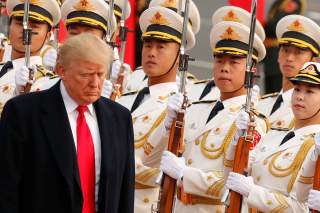The Chinese Century?
Regardless of how America responds to the Chinese challenge, its policy must be rooted in reality.
THE FACT that the five ideas discussed here face mounting doubts does not mean that U.S. officials were knaves ever to have entertained them. It was a bit whiggish—but not absurd—to think that China would evolve toward democracy at a time when so many authoritarian regimes were making that transition; it was certainly worth testing whether a nation of more than one billion people could be made a satisfied member of the international system. The United States could afford to emphasize reassurance and engagement in dealing with Beijing in the 1990s or even the early 2000s; there was a time when the China challenge was indeed far less immediate than other pressing dangers.
The trouble with the ideas that have guided America’s China policy, then, is not that they were clearly wrong to begin with. It is that they have now outlived their utility. As China’s revisionist ambitions and growing assertiveness become more pronounced, these concepts serve principally to obscure the nature and dimensions of the challenge, and to weaken the impetus to a sharper response. Ideas that seemed reasonable enough in their time have become increasingly dangerous today.
None of this is to say that America should precipitously shift from a strategy featuring strong elements of engagement to one that represents a caricature of Cold War–style containment—an approach that seeks not simply to stymie China’s geopolitical ascendancy, but to halt its economic growth, destabilize its political system and isolate it diplomatically. Such a strategy is unworkable, given China’s economic heft, significant diplomatic influence and status as primary trading partner to many U.S. partners and allies. Indeed, it is an ironic effect—call it a catastrophic success—of decades of U.S. and international engagement of China that containment of that country is now impossible.
Fortunately, such a policy is also unnecessary, because there are myriad intermediate steps Washington can take to compete more effectively: increasing military spending and accelerating development of capabilities that can puncture the Chinese A2/AD bubble; helping U.S. allies acquire cheap and plentiful A2/AD capabilities of their own to constrain Chinese maritime advances; imposing greater—if still selective—diplomatic and economic costs in response to gray-zone expansionism; limiting Beijing’s investment in sectors critical to national security and otherwise reducing the vulnerability of America and its friends to Chinese economic coercion; and investing more in the geoeconomic elements of statecraft. These steps all entail a willingness to court increased tensions with Beijing, but they are not inherently incompatible with continued commerce or cooperation on issues of mutual concern. If the United States and the Soviet Union could collaborate on nuclear nonproliferation, arms control and the eradication of smallpox amid the Cold War, surely a more competitive strategy toward China would not preclude all forms of engagement today.
Regardless of how America responds to the Chinese challenge, however, its policy must be rooted in reality. Preventing an increasingly confident great power from remaking the East Asian order, and perhaps challenging U.S. interests globally, will be the defining challenge of American statecraft in the twenty-first century. Meeting that challenge will be hard enough even if America dispenses with its China illusions; doing so will probably be impossible if it does not.
Hal Brands is the Henry A. Kissinger Distinguished Professor of Global Affairs at the Johns Hopkins School of Advanced International Studies (SAIS), senior fellow at the Center for Strategic and Budgetary Assessments, and author of American Grand Strategy in the Age of Trump.
Image: China's President Xi Jinping holds a welcome ceremony for U.S. President Donald Trump at the Great Hall of the People in Beijing, China November 9, 2017. REUTERS/Jonathan Ernst

